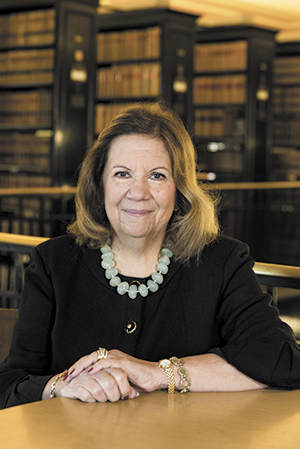Subscriber Benefit
As a subscriber you can listen to articles at work, in the car, or while you work out. Subscribe NowMary Beth Braitman handles a highly regulated and complex practice that’s built a national reach from her office at Ice Miller in Indianapolis. Braitman counsels public employee retirement systems in 41 states as well as health and other benefit plans, guiding them through myriad regulatory compliance mazes while also helping the plans meet their fiduciary obligations and offer innovations. Braitman is described as a trailblazer in her practice area who paved the way for other women, but she’s humble about her experience that began with working at the Internal Revenue Service in the 1970s and going to law school at night. Braitman, a colleague said, “says she never had to be aggressive as a woman in her field; she earned respect through professionalism and commitment to the work.”
 Who is someone who inspired or mentored you, and what did you learn from them?
Who is someone who inspired or mentored you, and what did you learn from them?
Three senior partners with whom I worked constantly during my first years of practicing law. They taught me about meeting individual clients’ expectations and needs, in a way each client thought was the most helpful and constructive. They were very supportive and encouraging.
What’s been the most rewarding aspect of your practice?
The opportunity to work with wonderful people across the country who manage public employee retirement systems. Their work truly is a labor of love that makes a real difference in government employees’ lives.
You’re active with the Eiteljorg Museum. What’s your favorite part of that involvement?
Attending the Museum’s programs and exhibits — from the finest in contemporary Native American works to our special focus exhibits. Those include last year’s exhibit “Dogs: Faithful and True” (where dogs visited the Museum on weekends and Wednesday evenings) and now the “Reel West.” In addition, we have a robust and beautiful permanent collection. Visit the Eiteljorg. You’ll be surprised by what you’ll see!
What do you most enjoy doing when you're not in the office?
Working on my close to 100-year-old house — with all the surprises (both happy and sad!) that it brings.
What advice would you give your younger self?
Two somewhat contradictory thoughts: One, “Be more focused on the present.” When at home, focus on family and home. When at work, focus on work. Don’t constantly worry about what you’re not doing each moment. Two, when possible, integrate family with your career. I attended meetings of one national organization for 30 years. My husband and son (before he went to college) came to the vast majority of those meetings held around the country, and we took summer vacations after the conference was over. My husband and son made friends with other lawyers’ families, and this created wonderful memories for all three of us.
When did you first decide you would become a lawyer, and what motivated you?
When I was with the Internal Revenue Service doing employee benefit plan work, I realized I could more directly help employers create and sustain appropriate benefit plans as a lawyer. I worked during the day and attended law school 5 nights a week. That schedule kept me motivated to finish quickly.
What’s something about you not many people know?
I love to work on my flower garden, some of which a recent addition to the family (fondly known as the “demon puppy”) has managed to destroy this winter, so there is a lot to do this spring.
You’ve mentored many young lawyers. Is the advice different in a highly technical practice area such as yours?
To some extent. I think you have to thrive on constant change — from Congress, state legislatures, and federal regulations. It can be compared to solving complex puzzles, where the pieces get shuffled frequently.
What has been your most memorable case?
My most memorable projects included two things that were not cases, but they were career changing. The first (in 1987) was to attend a meeting of a few lawyers around the country who worked with governmental pension plans that thought it would be very helpful to get to know each other and share peer information. That led to discussions of forming some type of association. Later in 1987, the National Association of Public Pension Attorneys (NAPPA) was formed, with 53 members. Today, that association exceeds 700 members. Being part of that initial group, and later serving on the board of directors and as president of NAPPA, was very memorable for the 30 years I was involved in NAPPA. The other memorable aspect of my career was serving as a founding member of the Advisory Committee on Tax Exempt and Governmental Entities (TEGE) created by the IRS.
How do you see the legal profession changing in the next decade?
I honestly do not know, but I am sure some number of people will still have wonderful careers as lawyers.
What was your most memorable job before becoming an attorney?
Working at the Internal Revenue Service. I learned professionalism and methods of resolving problems that were compliant with federal law in a reasonable and fair manner.
How has the practice of law changed since you become a lawyer?
Countless ways in terms of expectations and communications. One example I have concerns about is the “shorthand” dialog that can occur in long email strings where it is not clear in the end what was or was not taken account of in the answer.•
Please enable JavaScript to view this content.
